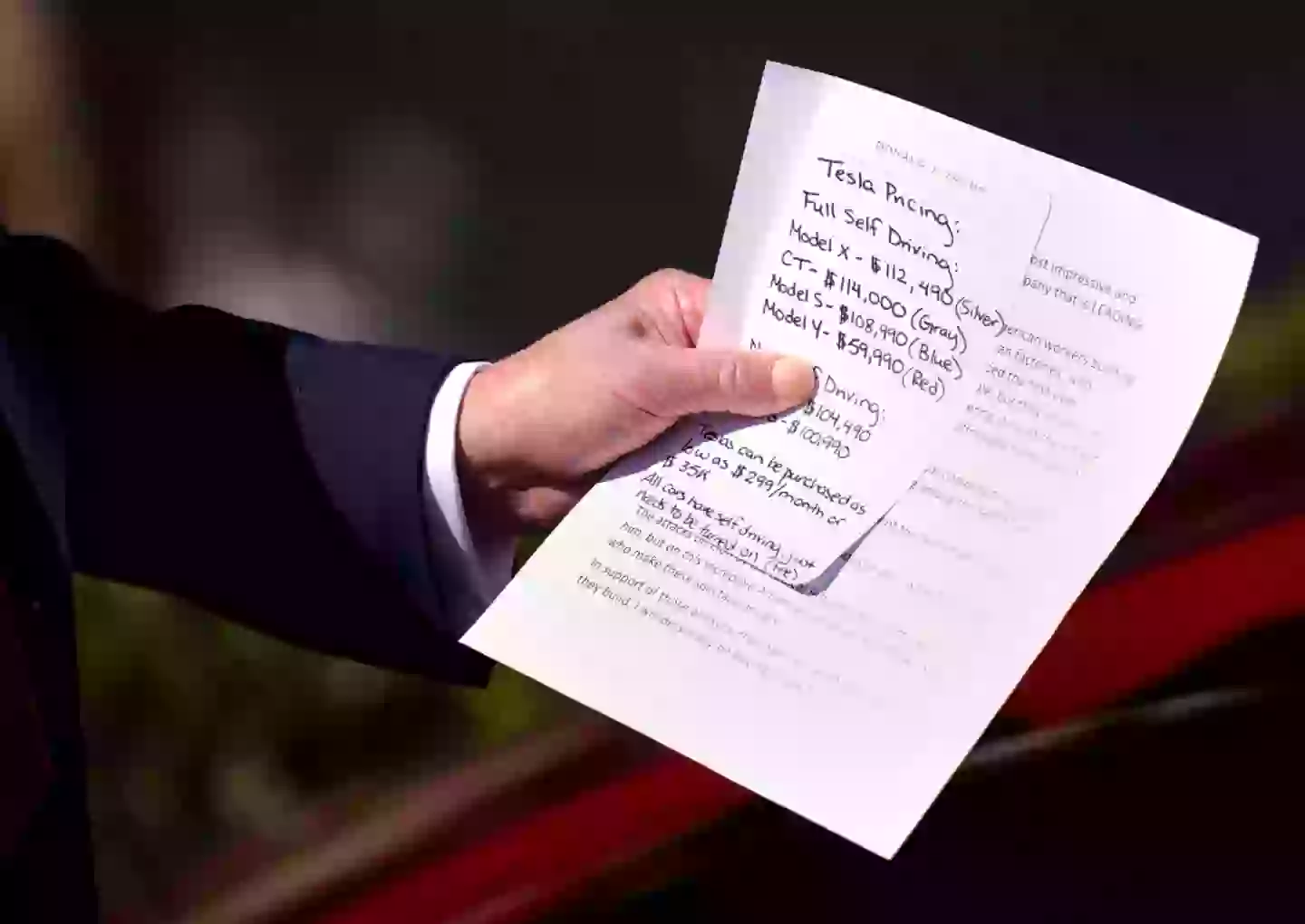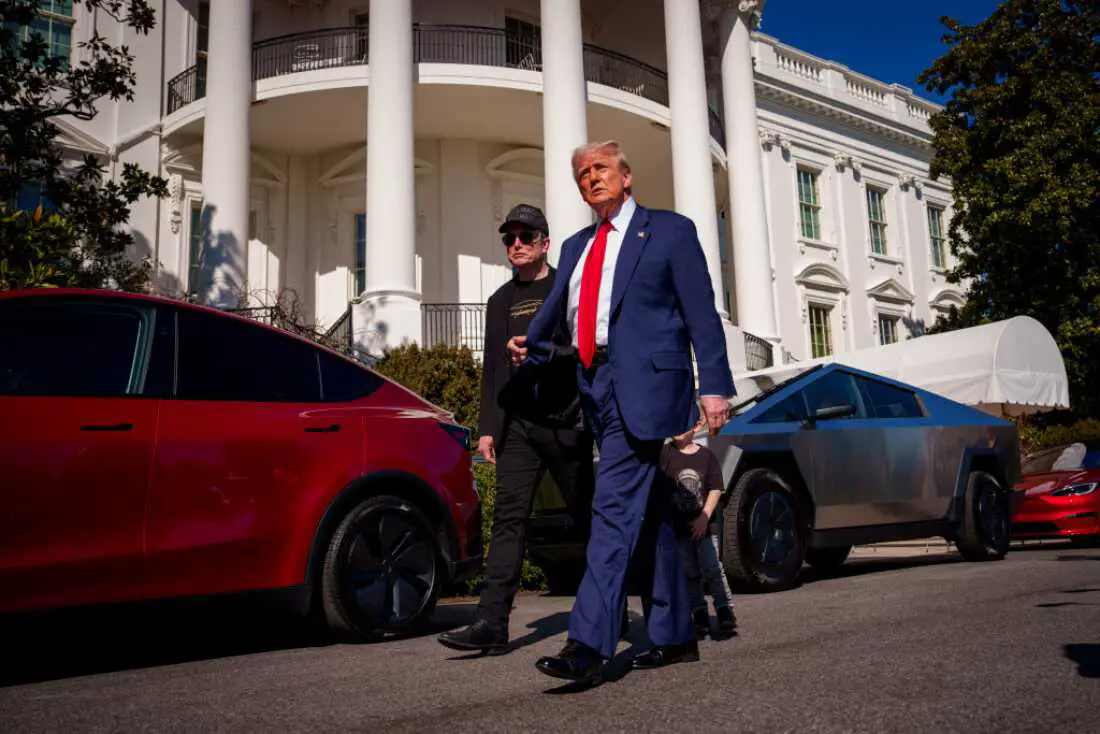Recent events at the White House have provided a new chapter in the evolving narrative of corporate support, political spectacle, and media scrutiny. In a widely circulated incident, former President Donald Trump was observed perusing a lineup of Tesla vehicles alongside Elon Musk’s entourage. The scene, captured on video and shared extensively online, quickly drew public attention not only for the display of electric vehicles on the iconic grounds but also for a handwritten document seen in Trump’s possession. This document, a detailed note listing Tesla pricing and features, became a focal point of discussion among social media users and political commentators alike.
I. Setting the Scene: Tesla’s Display and the White House Backdrop
On Tuesday, March 11, a diverse selection of Tesla models was prominently displayed in front of the White House. The showcase featured various electric cars, including the futuristic Cybertruck, all under the banner of supporting Elon Musk’s business initiatives. The event was not a typical automotive expo; it carried the distinct political undertones characteristic of former President Trump’s public appearances.
The selection of vehicles was arranged to highlight Tesla’s innovative technology and competitive pricing—a strategy intended to bolster public confidence in the brand at a time when its stock had recently experienced significant volatility. Against the backdrop of the nation’s capital, the scene took on an added layer of symbolism, merging the realms of commerce, technology, and politics.
II. The Document That Sparked Conversation
While the display of Teslas was the central attraction, what truly caught the attention of onlookers and online commentators was a piece of paper in Trump’s hand. The document was not a generic press release or a fleeting note; it was a detailed list of pricing information and product features for various Tesla models. The note was observed by eagle-eyed viewers who quickly shared images and commentary across social media platforms, igniting discussions about its contents and implications.
A. A Detailed Breakdown of Tesla Pricing
The handwritten note featured at the top a section dedicated to “Tesla Pricing” and included several lines outlining the cost structure of different models, along with options for the much-discussed Full Self Driving package. According to the note, the following pricing details were recorded:
- Model X: Priced at $112,490 in silver.
- CT: Listed at $114,000 in gray.
- Model S: Costing $108,990 in blue.
- Model Y: Available for $59,990 in red.
These figures were followed by additional cost details, including a note that stated, “Teslas can be purchased as low as $299/month of $35k. All cars have self driving, just needs to be turned on (fee).” Such comprehensive pricing information is typically found on corporate websites or printed brochures but was notable here because it was seen in the context of a public display event.

B. Public and Media Reaction
The document quickly became a talking point online, with many users expressing surprise at the level of detail and its presence during an official White House event. Social media users on platforms such as Reddit were particularly vocal. Comments ranged from astonishment at the blending of political spectacle and commercial promotion to critiques suggesting that the note inadvertently cast Trump in the role of an informal car salesperson.
One Reddit user remarked that the image of the document “will be remembered as one of those moments that go down in history for all the wrong reasons.” Another commented, with a mix of humor and disbelief, that the former president appeared to be “a literal car salesman.” There were even calls from some quarters for a stricter separation between official press events and corporate advertising—a reflection of the broader debate about the use of government platforms for promoting private business interests.
III. Contextualizing the Event: Trump’s Support for Musk and Tesla
The appearance of Tesla vehicles at the White House was part of a larger narrative in which former President Trump declared his intention to publicly support Elon Musk’s business ventures. During the event, Trump attributed the recent downturn in Tesla’s stock to what he described as a boycott by the “Radical Left.” He argued that this political maneuver was designed to “attack and do harm to Elon” Musk. In response, Trump announced his plans to purchase a brand-new Tesla, stating that this move was intended as a demonstration of confidence in Musk’s vision and the company’s future.
A. Political Undertones and Corporate Alliances
Trump’s public support for Tesla and Musk underscores a complex interplay between politics and business. His remarks suggested that political forces were influencing market dynamics, particularly targeting companies that are seen as innovative disruptors in their respective industries. By positioning himself as a champion of Musk and his ventures, Trump sought to align his brand with progressive technological advancements while simultaneously criticizing political opponents for allegedly undermining American innovation.
B. The Role of Public Image and Branding
The event was carefully orchestrated to send a strong message: in a time of economic and political uncertainty, trust in American enterprise and technological innovation remains paramount. By buying into Tesla—both literally and figuratively—Trump aimed to restore confidence among investors and the general public. His praise for the products was evident during interactions with reporters, where he noted the superior quality of the vehicles. For instance, he specifically described a red Tesla Model S as “beautiful” and expressed admiration for its advanced interior design, exclaiming, “Everything’s computer!”
This enthusiastic endorsement, juxtaposed with the presence of the detailed pricing note, reinforced the impression that the event was more than a mere promotional outing—it was a carefully staged demonstration of political and economic ideology.
IV. Dissecting the Handwritten Note: Beyond Pricing Details
The detailed document held by Trump provided more than just a rundown of Tesla’s offerings. It served as a tangible artifact that bridged the gap between corporate marketing and political spectacle. Its contents, particularly the breakdown of pricing and financing options, offer insights into Tesla’s market strategy and the messaging that Trump intended to convey.
A. Analysis of the Pricing Strategy
The note’s detailed pricing information suggests that Tesla positions its products not only as cutting-edge technological innovations but also as accessible to a broad range of consumers. The inclusion of financing options—highlighting that vehicles could be purchased for as little as $299 per month on a $35,000 plan—demonstrates an effort to make high-quality electric vehicles more attainable to a wider demographic. This approach has long been a part of Tesla’s strategy, appealing to consumers who are enthusiastic about technology yet sensitive to the high initial cost of electric vehicles.
B. Implications for Market Confidence
Trump’s decision to publicly endorse Tesla by purchasing one of its vehicles carries significant implications for market confidence. Public figures of his stature have historically influenced public sentiment, and his support can be interpreted as a vote of confidence in the company’s long-term viability. Moreover, the detailed note, which appeared to function as a quick-reference guide for pricing and features, subtly reinforces the idea that even high-level political figures are making informed, data-driven decisions when aligning themselves with corporate brands.
C. Bridging Corporate and Political Narratives
The seamless integration of commercial details with political messaging in the note illustrates how modern public events often blur the lines between government activity and private enterprise. By showcasing a handwritten document that contained concrete, actionable information about Tesla vehicles, the event blurred traditional boundaries and sparked discussions about the appropriate role of public office in private commerce. Critics argued that such instances could undermine the integrity of government-sponsored events, while supporters maintained that the display underscored a genuine belief in American innovation and market freedom.
V. Broader Public and Media Perspectives
The online response to the incident has been multifaceted, reflecting broader societal debates over the intersection of politics, business, and media. Social media platforms such as Reddit, Twitter, and Facebook provided a fertile ground for diverse opinions, from humorous jabs to serious critiques regarding the misuse of official platforms for corporate promotion.
A. Social Media Reactions
Many internet users were quick to dissect every detail of the incident. The detailed pricing note, in particular, became a symbol for those who viewed the event as emblematic of a broader trend in which political figures are increasingly entangled in commercial endorsements. Comments ranged from expressions of incredulity to sharp criticisms suggesting that the former president’s actions could be construed as an endorsement of policies that favor his billionaire associates. The sentiment that emerged from these discussions was one of skepticism regarding the appropriateness of such public displays.
B. Analysis by Media Commentators
Media analysts have weighed in on the incident by highlighting its potential implications for public trust in both political leadership and corporate governance. Some commentators argued that the integration of product details in a White House event could be seen as blurring the lines between official government communication and private advertisement. Others pointed out that the event was a calculated move by Trump to demonstrate his support for Tesla and, by extension, the broader narrative of American entrepreneurship and technological progress.
C. Political and Economic Implications
The incident has also reignited debates about the role of corporate endorsements in political discourse. Trump’s remarks, coupled with the display of detailed product information, have been interpreted by some as an effort to leverage government attention to influence market perceptions. This has raised questions about the ethical considerations of using high-profile political events as platforms for corporate promotion. The discussion extends to concerns about transparency, accountability, and the potential impact on policy-making, particularly in a climate where public trust in governmental institutions is already under intense scrutiny.
VI. The Intersection of Technology, Politics, and Consumer Culture
At its core, the incident encapsulates the modern convergence of technology, politics, and consumer culture. Electric vehicles, and Tesla in particular, have come to symbolize more than just a mode of transportation—they represent a shift in societal values toward sustainability, innovation, and economic progress. When public figures such as Trump engage with these symbols, their actions resonate on multiple levels.
A. The Symbolism of Electric Vehicles
Electric vehicles have emerged as a powerful symbol of technological advancement and environmental responsibility. Tesla, as a brand, has been at the forefront of this movement, consistently pushing the envelope in terms of performance, design, and sustainable innovation. The company’s ability to capture the public’s imagination has made it a frequent subject of both praise and scrutiny. The detailed pricing note seen in Trump’s hand provided a tangible link to Tesla’s core message: that innovation can be both high-tech and accessible.
B. Political Capital and Corporate Branding
For political figures, aligning with a successful, forward-thinking brand like Tesla offers a unique opportunity to bolster their own image. In the case of Trump, his public endorsement of Tesla came at a time when he was keen to demonstrate support for business leaders like Elon Musk, whose ventures are often seen as emblematic of American ingenuity. By publicly affirming his confidence in Tesla—both through verbal endorsements and the act of reviewing detailed product information—Trump tapped into the broader cultural narrative that champions entrepreneurship and innovation as drivers of national progress.
C. The Role of Documentation in Shaping Public Narratives
The presence of the handwritten document added an unexpected element to the event. While its contents were strictly commercial in nature, the document also served as a potent symbol of transparency—or, as some critics argue, the lack thereof. In an era when detailed information is readily available online, the decision to highlight such specifics in a public setting invites debate about how data should be presented and contextualized. Whether viewed as an innocuous artifact or as evidence of deeper issues in the interplay between public office and private enterprise, the document has undoubtedly played a role in shaping the narrative that emerged from the event.
VII. Lessons Learned and Future Implications
The incident offers several key takeaways for both political figures and corporate leaders. As the lines between public service and private interests continue to blur, the need for clear ethical guidelines and transparent practices becomes ever more pressing.
A. Transparency and Accountability in Public Events
One of the most significant lessons from the event is the importance of maintaining clear boundaries between governmental activities and private commercial interests. While public figures are entitled to their personal opinions and business affiliations, the use of official platforms to promote private products can undermine public trust. Establishing and adhering to robust guidelines that govern such interactions is essential for preserving the integrity of public institutions.
B. The Role of Media Literacy
In today’s digital age, where every detail of a public event can be scrutinized and dissected online, media literacy has become an essential skill for the public. The detailed discussion sparked by the handwritten note underscores the power of social media to shape narratives. It also highlights the importance of critically evaluating the sources and contexts of the information being shared.
C. Balancing Innovation with Ethical Considerations
For companies like Tesla, which operate at the intersection of technology and consumer culture, maintaining a balance between innovation and ethical marketing is crucial. The incident serves as a reminder that while aggressive promotion can drive interest and market performance, it must be conducted within ethical boundaries that respect public sensibilities and regulatory norms. Similarly, political figures must carefully weigh the implications of their endorsements and public statements, ensuring that they do not inadvertently compromise the trust placed in them by the public.
VIII. Concluding Thoughts
The appearance of Tesla vehicles at the White House, coupled with the display of a detailed pricing document in the hands of former President Donald Trump, has provided a vivid illustration of the complex intersections between technology, politics, and consumer culture. This incident, though seemingly trivial at first glance, has sparked a wide-ranging conversation about the appropriate use of official platforms, the impact of corporate endorsements on political narratives, and the evolving expectations of transparency and accountability in public discourse.
As the discussion continues both online and in more formal media channels, several key themes have emerged:
- The Integration of Commerce and Politics: The event underscored how modern political figures increasingly engage with corporate brands as part of their public persona, often blurring the lines between personal endorsement and official advocacy.
- Public Scrutiny in the Digital Age: The rapid spread of images and commentary on social media illustrates the heightened level of public scrutiny that accompanies high-profile events. Every detail, from a handwritten note to a casual remark, is subject to extensive analysis.
- The Importance of Ethical Guidelines: In an era where government and private enterprise are more intertwined than ever, establishing clear ethical standards for public events is essential to maintain public trust and ensure fair practices.
In summary, the incident serves as a case study in the complexities of modern public life. It provides an opportunity to reflect on how personal branding, corporate marketing, and political messaging converge in high-stakes environments like the White House. As both technology and politics continue to evolve, the lessons learned from this event are likely to influence future practices in public relations, regulatory policy, and the broader dialogue about the role of innovation in society.
The enduring impact of this incident will be seen in how it shapes future public events and the strategies of political figures who seek to balance personal interests with their responsibilities to the public. As debates around these issues intensify, it remains clear that transparency, accountability, and ethical conduct are more critical than ever for ensuring that public discourse remains informed, balanced, and respectful of the complex dynamics at play.
This article is intended to provide an in‐depth analysis of the recent events surrounding Tesla’s display at the White House, the detailed document seen in Donald Trump’s possession, and the ensuing public reaction. It is designed to offer a comprehensive perspective for readers interested in the intersection of technology, politics, and media, and to foster a deeper understanding of the challenges and opportunities that arise when these worlds converge.

Lila Hart is a dedicated Digital Archivist and Research Specialist with a keen eye for preserving and curating meaningful content. At TheArchivists, she specializes in organizing and managing digital archives, ensuring that valuable stories and historical moments are accessible for generations to come.
Lila earned her degree in History and Archival Studies from the University of Edinburgh, where she cultivated her passion for documenting the past and preserving cultural heritage. Her expertise lies in combining traditional archival techniques with modern digital tools, allowing her to create comprehensive and engaging collections that resonate with audiences worldwide.
At TheArchivists, Lila is known for her meticulous attention to detail and her ability to uncover hidden gems within extensive archives. Her work is praised for its depth, authenticity, and contribution to the preservation of knowledge in the digital age.
Driven by a commitment to preserving stories that matter, Lila is passionate about exploring the intersection of history and technology. Her goal is to ensure that every piece of content she handles reflects the richness of human experiences and remains a source of inspiration for years to come.
